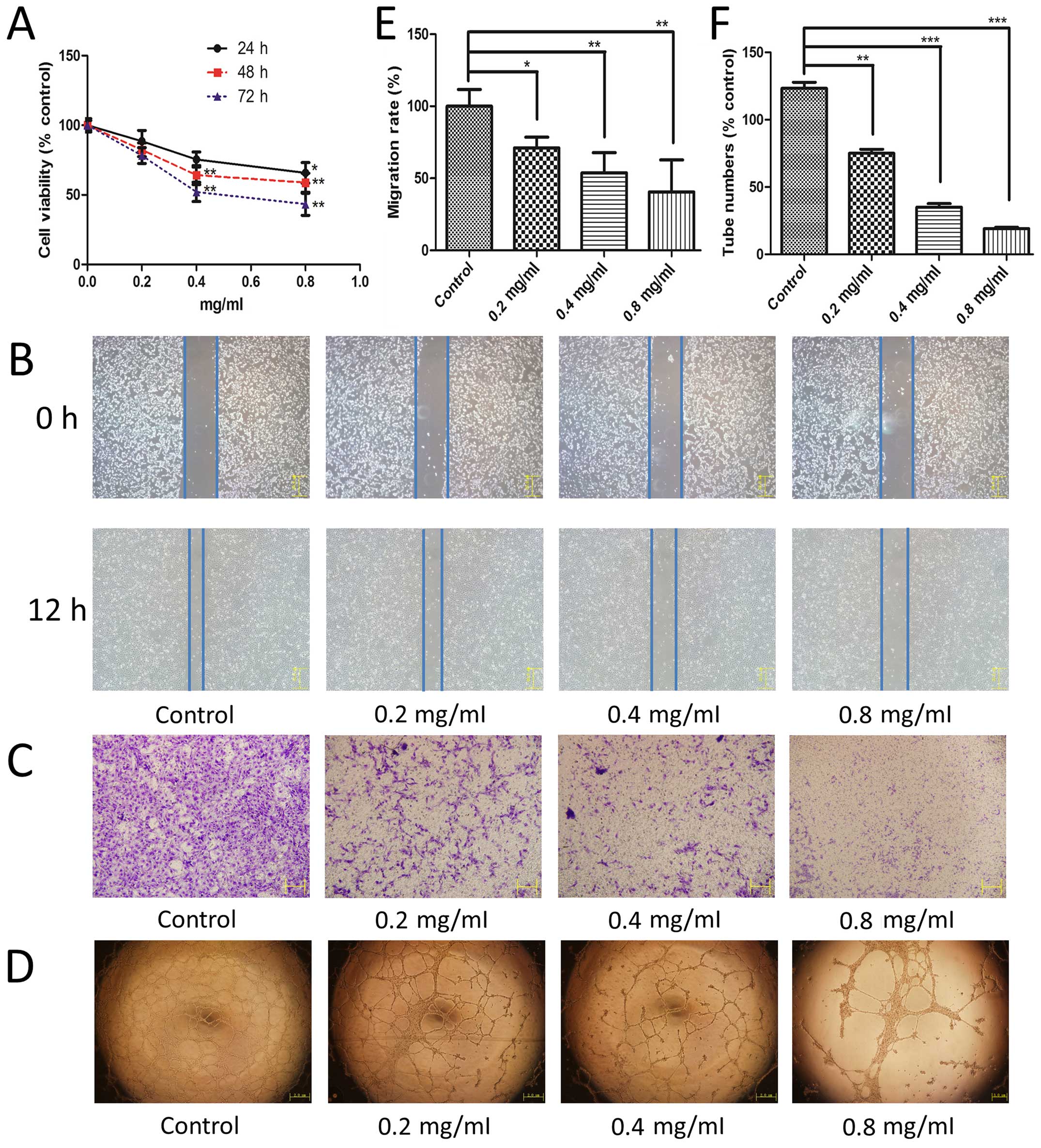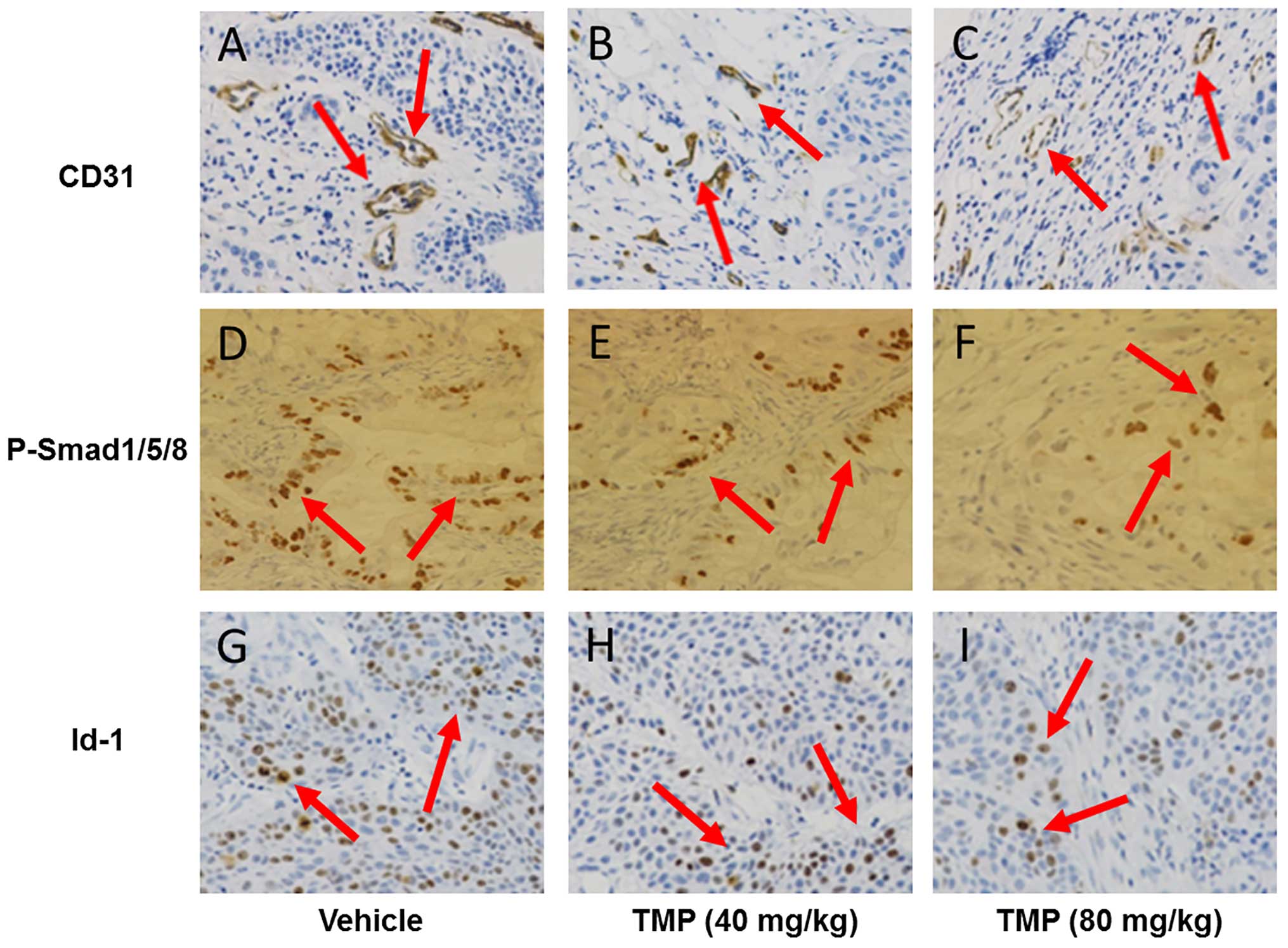|
1
|
Zheng CY, Xiao W, Zhu MX, Pan XJ, Yang ZH
and Zhou SY: Inhibition of cyclooxygenase-2 by tetramethylpyrazine
and its effects on A549 cell invasion and metastasis. Int J Oncol.
40:2029–2037. 2012.PubMed/NCBI
|
|
2
|
Yan JH, Zhao CL, Ding LB and Zhou X: FOXD3
suppresses tumor growth and angiogenesis in non-small cell lung
cancer. Biochem Biophys Res Commun. 466:111–116. 2015. View Article : Google Scholar : PubMed/NCBI
|
|
3
|
Zhengfu H, Hu Z, Huiwen M, Zhijun L,
Jiaojie Z, Xiaoyi Y and Xiujun C: 1-o-acetylbritannilactone (ABL)
inhibits angiogenesis and lung cancer cell growth through
regulating VEGF-Src-FAK signaling. Biochem Biophys Res Commun.
464:422–427. 2015. View Article : Google Scholar : PubMed/NCBI
|
|
4
|
Yi B, Liu D, He M, Li Q, Liu T and Shao J:
Role of the ROS/ AMPK signaling pathway in
tetramethylpyrazine-induced apoptosis in gastric cancer cells.
Oncol Lett. 6:583–589. 2013.PubMed/NCBI
|
|
5
|
Zheng Z, Li Z, Chen S, Pan J and Ma X:
Tetramethylpyrazine attenuates TNF-α-induced iNOS expression in
human endothelial cells: Involvement of Syk-mediated activation of
PI3K-IKK-IκB signaling pathways. Exp Cell Res. 319:2145–2151. 2013.
View Article : Google Scholar : PubMed/NCBI
|
|
6
|
Cai X, Chen Z, Pan X, Xia L, Chen P, Yang
Y, Hu H, Zhang J, Li K, Ge J, et al: Inhibition of angiogenesis,
fibrosis and thrombosis by tetramethylpyrazine: Mechanisms
contributing to the SDF-1/CXCR4 axis. PLoS One. 9:e881762014.
View Article : Google Scholar : PubMed/NCBI
|
|
7
|
Wang X-Y, Ma Z-C, Wang Y-G, Tan HL, Xiao
CR, Liang QD, Tang XL, Cheng Y and Gao Y: Tetramethylpyrazine
protects lymphocytes from radiation-induced apoptosis through
nuclear factor-κB. Chin J Nat Med. 12:730–737. 2014.PubMed/NCBI
|
|
8
|
Cao J, Miao Q, Miao S, Bi L, Zhang S, Yang
Q, Zhou X, Zhang M, Xie Y, Zhang J, et al: Tetramethylpyrazine
(TMP) exerts antitumor effects by inducing apoptosis and autophagy
in hepatocellular carcinoma. Int Immunopharmacol. 26:212–220. 2015.
View Article : Google Scholar : PubMed/NCBI
|
|
9
|
Chen Z, Pan X, Georgakilas AG, Chen P, Hu
H, Yang Y, Tian S, Xia L, Zhang J, Cai X, et al:
Tetramethylpyrazine (TMP) protects cerebral neurocytes and inhibits
glioma by down regulating chemokine receptor CXCR4 expression.
Cancer Lett. 336:281–289. 2013. View Article : Google Scholar : PubMed/NCBI
|
|
10
|
Yan Y, Zhao J, Cao C, Jia Z, Zhou N, Han
S, Wang Y, Xu Y, Zhao J, Yan Y, et al: Tetramethylpyrazine promotes
SH-SY5Y cell differentiation into neurons through epigenetic
regulation of Topoisomerase IIβ. Neuroscience. 278:179–193. 2014.
View Article : Google Scholar : PubMed/NCBI
|
|
11
|
Kim M, Kim S-O, Lee M, Lee JH, Jung WS,
Moon SK, Kim YS, Cho KH, Ko CN and Lee EH: Tetramethylpyrazine, a
natural alkaloid, attenuates pro-inflammatory mediators induced by
amyloid β and interferon-γ in rat brain microglia. Eur J Pharmacol.
740:504–511. 2014. View Article : Google Scholar : PubMed/NCBI
|
|
12
|
Zhang Y, Liu X, Zuo T, Liu Y and Zhang JH:
Tetramethylpyrazine reverses multidrug resistance in breast cancer
cells through regulating the expression and function of
P-glycoprotein. Med Oncol. 29:534–538. 2012. View Article : Google Scholar
|
|
13
|
Yan YX, Zhao JX, Han S, Zhou NJ, Jia ZQ,
Yao SJ, Cao CL, Wang YL, Xu YN, Zhao J, et al: Tetramethylpyrazine
induces SH-SY5Y cell differentiation toward the neuronal phenotype
through activation of the PI3K/Akt/Sp1/TopoIIβ pathway. Eur J Cell
Biol. 94:626–641. 2015. View Article : Google Scholar : PubMed/NCBI
|
|
14
|
Du H, Shi H, Chen D, Zhou Y and Che G:
Cross-talk between endothelial and tumor cells via basic fibroblast
growth factor and vascular endothelial growth factor signaling
promotes lung cancer growth and angiogenesis. Oncol Lett.
9:1089–1094. 2015.PubMed/NCBI
|
|
15
|
Li Y, Li S, Sun D, Song L and Liu X:
Expression of 15-hydroxy-prostaglandin dehydrogenase and
cyclooxygenase-2 in non-small cell lung cancer: Correlations with
angiogenesis and prognosis. Oncol Lett. 8:1589–1594.
2014.PubMed/NCBI
|
|
16
|
Cejalvo T, Sacedón R, Hernández-López C,
Diez B, Gutierrez-Frías C, Valencia J, Zapata AG, Varas A and
Vicente A: Bone morphogenetic protein-2/4 signalling pathway
components are expressed in the human thymus and inhibit early
T-cell development. Immunology. 121:94–104. 2007. View Article : Google Scholar : PubMed/NCBI
|
|
17
|
Ling MT, Wang X, Tsao SW and Wong YC:
Down-regulation of Id-1 expression is associated with TGF beta
1-induced growth arrest in prostate epithelial cells. Biochim
Biophys Acta. 1570:145–152. 2002. View Article : Google Scholar : PubMed/NCBI
|
|
18
|
Qiu H, Yang B, Pei ZC, Zhang Z and Ding K:
WSS25 inhibits growth of xenografted hepatocellular cancer cells in
nude mice by disrupting angiogenesis via blocking bone
morphogenetic protein (BMP)/Smad/Id1 signaling. J Biol Chem.
285:32638–32646. 2010. View Article : Google Scholar : PubMed/NCBI
|
|
19
|
Song X, Liu S, Qu X, Hu Y, Zhang X, Wang T
and Wei F: BMP2 and VEGF promote angiogenesis but retard terminal
differentiation of osteoblasts in bone regeneration by
up-regulating Id1. Acta Biochim Biophys Sin (Shanghai). 43:796–804.
2011. View Article : Google Scholar
|
|
20
|
Beets K, Huylebroeck D, Moya IM, Umans L
and Zwijsen A: Robustness in angiogenesis: Notch and BMP shaping
waves. Trends Genet. 29:140–149. 2013. View Article : Google Scholar : PubMed/NCBI
|
|
21
|
Bao P, Kodra A, Tomic-Canic M, Golinko MS,
Ehrlich HP and Brem H: The role of vascular endothelial growth
factor in wound healing. J Surg Res. 153:347–358. 2009. View Article : Google Scholar :
|
|
22
|
Wang S, Cai R, Ma J, Liu T, Ke X, Lu H and
Fu J: The natural compound codonolactone impairs tumor induced
angiogenesis by downregulating BMP signaling in endothelial cells.
Phytomedicine. 22:1017–1026. 2015. View Article : Google Scholar : PubMed/NCBI
|
|
23
|
Rothhammer T, Bataille F, Spruss T,
Eissner G and Bosserhoff AK: Functional implication of BMP4
expression on angiogenesis in malignant melanoma. Oncogene.
26:4158–4170. 2007. View Article : Google Scholar
|
|
24
|
Liu D, Wang J, Kinzel B, Müeller M, Mao X,
Valdez R, Liu Y and Li E: Dosage-dependent requirement of BMP type
II receptor for maintenance of vascular integrity. Blood.
110:1502–1510. 2007. View Article : Google Scholar : PubMed/NCBI
|
|
25
|
Wu MY and Hill CS: TGF-beta superfamily
signaling in embryonic development and homeostasis. Dev Cell.
16:329–343. 2009. View Article : Google Scholar : PubMed/NCBI
|
|
26
|
Conidi A, Cazzola S, Beets K, Coddens K,
Collart C, Cornelis F, Cox L, Joke D, Dobreva MP, Dries R, et al:
Few Smad proteins and many Smad-interacting proteins yield multiple
functions and action modes in TGFβ/BMP signaling in vivo. Cytokine
Growth Factor Rev. 22:287–300. 2011. View Article : Google Scholar : PubMed/NCBI
|
|
27
|
Morikawa M, Koinuma D, Miyazono K and
Heldin CH: Genome-wide mechanisms of Smad binding. Oncogene.
32:1609–1615. 2013. View Article : Google Scholar :
|
|
28
|
Valdimarsdottir G, Goumans MJ, Rosendahl
A, Brugman M, Itoh S, Lebrin F, Sideras P and ten Dijke P:
Stimulation of Id1 expression by bone morphogenetic protein is
sufficient and necessary for bone morphogenetic protein-induced
activation of endothelial cells. Circulation. 106:2263–2270. 2002.
View Article : Google Scholar : PubMed/NCBI
|
|
29
|
Fong S, Debs RJ and Desprez PY: Id genes
and proteins as promising targets in cancer therapy. Trends Mol
Med. 10:387–392. 2004. View Article : Google Scholar : PubMed/NCBI
|
|
30
|
Ling MT, Wang X, Zhang X and Wong YC: The
multiple roles of Id-1 in cancer progression. Differentiation.
74:481–487. 2006. View Article : Google Scholar : PubMed/NCBI
|
|
31
|
Fong S, Itahana Y, Sumida T, Singh J,
Coppe JP, Liu Y, Richards PC, Bennington JL, Lee NM, Debs RJ, et
al: Id-1 as a molecular target in therapy for breast cancer cell
invasion and metastasis. Proc Natl Acad Sci USA. 100:13543–13548.
2003. View Article : Google Scholar : PubMed/NCBI
|
|
32
|
Wang X, Xu K, Ling MT, Wong YC, Feng HC,
Nicholls J and Tsao SW: Evidence of increased Id-1 expression and
its role in cell proliferation in nasopharyngeal carcinoma cells.
Mol Carcinog. 35:42–49. 2002. View
Article : Google Scholar : PubMed/NCBI
|
|
33
|
Biswas S, Charlesworth PJ, Turner GD, Leek
R, Thamboo PT, Campo L, Turley H, Dildey P, Protheroe A, Cranston
D, et al: CD31 angiogenesis and combined expression of HIF-1α and
HIF-2α are prognostic in primary clear-cell renal cell carcinoma
(CC-RCC), but HIFα transcriptional products are not: Implications
for antiangiogenic trials and HIFα biomarker studies in primary
CC-RCC. Carcinogenesis. 33:1717–1725. 2012. View Article : Google Scholar : PubMed/NCBI
|
|
34
|
Miyata Y, Sagara Y, Watanabe S, Asai A,
Matsuo T, Ohba K, Hayashi T and Sakai H: CD105 is a more
appropriate marker for evaluating angiogenesis in urothelial cancer
of the upper urinary tract than CD31 or CD34. Virchows Arch.
463:673–679. 2013. View Article : Google Scholar : PubMed/NCBI
|
|
35
|
Kim SJ, Kim JS, Papadopoulos J, Wook Kim
S, Maya M, Zhang F, He J, Fan D, Langley R and Fidler IJ:
Circulating monocytes expressing CD31: Implications for acute and
chronic angiogenesis. Am J Pathol. 174:1972–1980. 2009. View Article : Google Scholar : PubMed/NCBI
|













